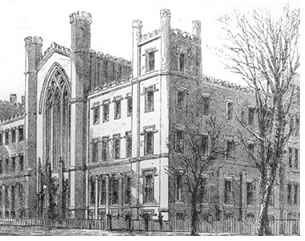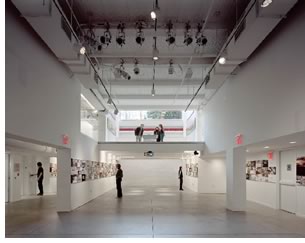

11/2005
by Tracy Ostroff
With the national community of architects of the Institute newly established in 1857, it was “only a matter of time before individual practitioners would gravitate into nuclei with aims resembling those of the Institute,” writes Henry H. Saylor, FAIA, in his history of the AIA’s first 100 years. The New York Chapter was established first in 1867 with, Saylor writes, “a personality of its own, a meeting place and, of course, a library.” Almost 150 years later, more than 300 state organizations and local chapters represent the AIA family.
The early development of the chapters was tied to the Institute structure. Each of the early chapter’s presidents, by mandate of the AIA Constitution of 1867, became a vice-president of the Institute. Following the organization of the New York Chapter were Philadelphia, 1869; Chicago, 1869; Cincinnati, 1870; Boston, 1870; Baltimore, 1871; Albany, 1873; Rhode Island, 1875; San Francisco, 1881; St. Louis, 1884; Indianapolis, 1884; and Washington, 1887.
Early on, AIA President Richard Upjohn recognized the dichotomy that could exist between the local organizations and the national body of architects. As noted in AIArchitect by former AIA Archivist Tony Wrenn, Hon. AIA., Upjohn reported in 1867 in his first convention speech “‘a radical change . . . effected in the organization of our society, consisting in the constitutional provision for chapters in affiliation with the general and national objects of the Institute, while yet, for local affairs, under the government of their own.” The New York Chapter was formally organized, it reported to the 1867 convention, “on the evening of March 19, 1867, at the Everett House.’” The next week, Wrenn writes, “chapters were legalized through bylaws changes. Regulations adopted required that chapter membership requirements ‘not be inconsistent with those required for Associate membership of the Institute, and that in other respects . . . regulations . . . not conflict.’ The AIA required that ‘all communications with Foreign bodies whether architectural or otherwise’ be conducted through the Institute.”
 Defining chapters
Defining chapters
By the Columbian Exposition at Chicago in 1893, Saylor notes, the Board
of Directors was concerned that no new chapters had been formed in
a year, and there had been no marked increase in membership. Saylor
notes the Institute directors recognized the cause as “the unsatisfactory
relationship of chapters to the parent body,” and worked to address
the concerns. “In 1897 the Convention in Detroit took an important
step toward democratization—a resolution that henceforth The
Institute was to be governed by delegates from the chapters. And again
the membership, aside from the honorary classification, was to revert
to the two classes adopted way back in 1867—Fellows and Associates,” Saylor
writes.
By the first part of the 20th century, chapter membership outgrew Institute membership and the structure of the Institute was questioned. “Chapters were waystations in which indication of fitness brought election to the Institute itself,” Saylor says. After evaluating its governing rules in 1915, the Institute voted to amend the Articles of Incorporation for the Institute to carry on its business and exercise its corporate powers outside the State of New York; to establish branches or chapters and hold property in other states; and to provide in its Constitution and Bylaws for elections by its members or by members of its chapters of the Institute. By doing so, Saylor writes, the organization codified what it had been doing in practice for many years. Furthermore, by 1916 Institute members were to be assigned to the chapters in the territory in which they resided. New chapters would be added by “splitting off territory for other groups from the holdings of present chapters—and with their consent.” Organizations that wanted to facilitate nearby meetings but still maintain ties to their large-territory chapter could become a division of the parent chapter.
The next year, the chapters “were forbidden to elect any new members of their own, though any chapter retained the right to create a class of members to be known as “Associates of the Chapter,” for those who agreed to apply for full Institute membership in the next three years.
By the 1940s, changes to the AIA Bylaws gave increasing power to the state associations. State associations soon took on an important role in Institute affairs, and, by 1940, “the idea of state associations becoming Institute members was being considered the best way to achieve the long-desired unification of the profession,” Saylor writes. The AIA Committee on Unification of the Profession addressed the difficulties as they arose, particularly as each state had their own take on how best to organize their sections.
 Family issues
Family issues
Like in any family, there were, according to historical sources, a difference
of opinions as to who should be driving the car, and who had front-seat
privileges. Saylor notes that in years of the Depression, state organizations
took on increasing importance as members reached locally for assistance
and camaraderie. In the early 1930s, “The idea as it crystallized
in the Convention of 1932 was that each association should pay an admission
fee of $25 for Institute State Association membership and annual dues
of $25. For this the associations were to have little authority in
Institute deliberations but would consult the parent body about joint
action or policy in any specific matters. The associations were to
pay dues but were to have their unit vote except on questions related
to the property of The Institute or its chapters. The Institute offered
a choice: either a state association could form a loose affiliation
with The Institute, or become a state association member as outlined
above.”
By 1935, a new bylaw mandated the addition of state chapters where they did not already exist and later the creation of the office of state association director, a member of the Board who would look after the interests of the state association members. During the next decade, “the idea of state associations becoming Institute members was being considered the best way to achieve the long-desired unification of the profession.” These groups would be represented by delegates. The Institute structure was further defined by 10 regional districts, with the Board made up of officer-directors, regional directors, and state association director. Representatives from the chapters and state associations would form regional organizations.
“There were difficulties all along the line,” Saylor notes, which the Committee on Unification of the Profession addressed as each problem became apparent. The framework for resolving these difficulties rallied around three principles: 1) To continue the present policy of encouraging state associations and their affiliation with the Institute through accredited delegates; 2) To continue efforts to bring into corporate membership all qualified architects of good character in the U.S.; 3) to look ahead to the idea of unification, with the AIA being the national organization of all qualified architects of good character formed in state organizations consisting of one or more chapters of AIA corporate meetings.”
This is not the end of the story of the AIA components. It is only the beginning of a relationship that continues to be defined, developed, and nurtured as the Institute expands to more than 75,000 members across the U.S., Guam & Micronesia, Puerto Rico, Virgin Islands, Continental Europe, London/UK, Hong Kong, and Japan.
Copyright 2005 The American Institute of Architects.
All rights reserved. Home Page ![]()
![]()
 |
||
View
the anniversary dates of the AIA components. Visit the component resource center
on the AIA Web site for more information on state and local chapters
and activities.
|
||